Comparison of marine spatial planning methods in Madagascar demonstrates value of alternative approaches
- PMID: 22359534
- PMCID: PMC3281012
- DOI: 10.1371/journal.pone.0028969
Comparison of marine spatial planning methods in Madagascar demonstrates value of alternative approaches
Abstract
The Government of Madagascar plans to increase marine protected area coverage by over one million hectares. To assist this process, we compare four methods for marine spatial planning of Madagascar's west coast. Input data for each method was drawn from the same variables: fishing pressure, exposure to climate change, and biodiversity (habitats, species distributions, biological richness, and biodiversity value). The first method compares visual color classifications of primary variables, the second uses binary combinations of these variables to produce a categorical classification of management actions, the third is a target-based optimization using Marxan, and the fourth is conservation ranking with Zonation. We present results from each method, and compare the latter three approaches for spatial coverage, biodiversity representation, fishing cost and persistence probability. All results included large areas in the north, central, and southern parts of western Madagascar. Achieving 30% representation targets with Marxan required twice the fish catch loss than the categorical method. The categorical classification and Zonation do not consider targets for conservation features. However, when we reduced Marxan targets to 16.3%, matching the representation level of the "strict protection" class of the categorical result, the methods show similar catch losses. The management category portfolio has complete coverage, and presents several management recommendations including strict protection. Zonation produces rapid conservation rankings across large, diverse datasets. Marxan is useful for identifying strict protected areas that meet representation targets, and minimize exposure probabilities for conservation features at low economic cost. We show that methods based on Zonation and a simple combination of variables can produce results comparable to Marxan for species representation and catch losses, demonstrating the value of comparing alternative approaches during initial stages of the planning process. Choosing an appropriate approach ultimately depends on scientific and political factors including representation targets, likelihood of adoption, and persistence goals.
Conflict of interest statement
Figures
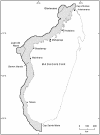

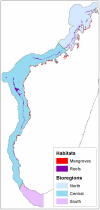
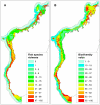

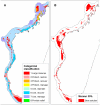
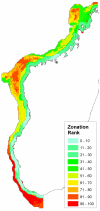

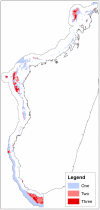
Similar articles
-
Incorporating conservation zone effectiveness for protecting biodiversity in marine planning.PLoS One. 2013 Nov 4;8(11):e78986. doi: 10.1371/journal.pone.0078986. eCollection 2013. PLoS One. 2013. PMID: 24223870 Free PMC article.
-
Evaluating approaches for scaling-up community-based marine-protected areas into socially equitable and ecologically representative networks.Conserv Biol. 2020 Feb;34(1):137-147. doi: 10.1111/cobi.13368. Epub 2019 Oct 1. Conserv Biol. 2020. PMID: 31206826
-
Accommodating dynamic oceanographic processes and pelagic biodiversity in marine conservation planning.PLoS One. 2011 Feb 2;6(2):e16552. doi: 10.1371/journal.pone.0016552. PLoS One. 2011. PMID: 21311757 Free PMC article.
-
New perspectives on sea use management: initial findings from European experience with marine spatial planning.J Environ Manage. 2009 Jan;90(1):77-88. doi: 10.1016/j.jenvman.2008.07.004. Epub 2008 Sep 10. J Environ Manage. 2009. PMID: 18786758 Review.
-
Strengths and complementarity of systematic conservation planning and Key Biodiversity Area approaches for spatial planning.Conserv Biol. 2025 Apr;39(2):e14400. doi: 10.1111/cobi.14400. Epub 2024 Oct 15. Conserv Biol. 2025. PMID: 39403036 Free PMC article. Review.
Cited by
-
Conservation Planning for Coral Reefs Accounting for Climate Warming Disturbances.PLoS One. 2015 Nov 4;10(11):e0140828. doi: 10.1371/journal.pone.0140828. eCollection 2015. PLoS One. 2015. PMID: 26535586 Free PMC article.
-
Modeling Reef Fish Biomass, Recovery Potential, and Management Priorities in the Western Indian Ocean.PLoS One. 2016 May 5;11(5):e0154585. doi: 10.1371/journal.pone.0154585. eCollection 2016. PLoS One. 2016. PMID: 27149673 Free PMC article.
-
Integrating climate adaptation and biodiversity conservation in the global ocean.Sci Adv. 2019 Nov 27;5(11):eaay9969. doi: 10.1126/sciadv.aay9969. eCollection 2019 Nov. Sci Adv. 2019. PMID: 31807711 Free PMC article.
-
Habitat-forming bryozoans in New Zealand: their known and predicted distribution in relation to broad-scale environmental variables and fishing effort.PLoS One. 2013 Sep 23;8(9):e75160. doi: 10.1371/journal.pone.0075160. eCollection 2013. PLoS One. 2013. PMID: 24086460 Free PMC article.
-
Quantifying the Short-Term Costs of Conservation Interventions for Fishers at Lake Alaotra, Madagascar.PLoS One. 2015 Jun 24;10(6):e0129440. doi: 10.1371/journal.pone.0129440. eCollection 2015. PLoS One. 2015. PMID: 26107284 Free PMC article.
References
-
- Worm B, Barbier EB, Beaumont N, Duffy JE, Folke C, et al. Impacts of biodiversity loss on ocean ecosystem services. Science. 2006;314:787–790. - PubMed
-
- Botsford LW, Castilla JC, Peterson CH. The Management of fisheries and marine ecosystems. Science. 1997;277:509–515.
-
- Worm B, Hilborn R, Baum JK, Branch TA, Collie JS, et al. Rebuilding global fisheries. Science. 2009;325:578–585. - PubMed
-
- McClanahan TR, Graham NAJ, Calnan JM, MacNeil MA. Toward pristine biomass: reef fish recovery in coral reef marine protected areas in Kenya. Ecological Applications. 2007;17:1055–1067. - PubMed

